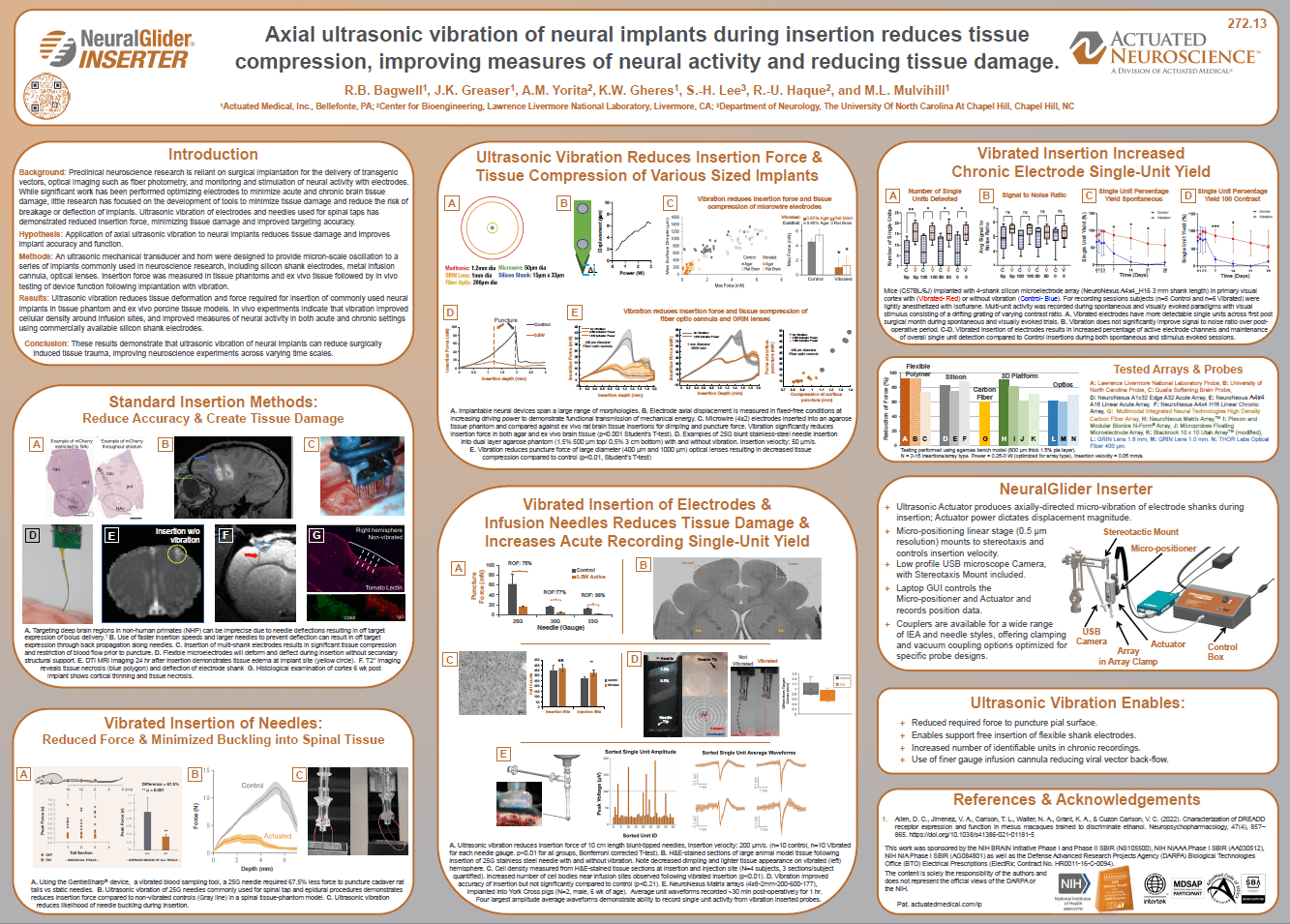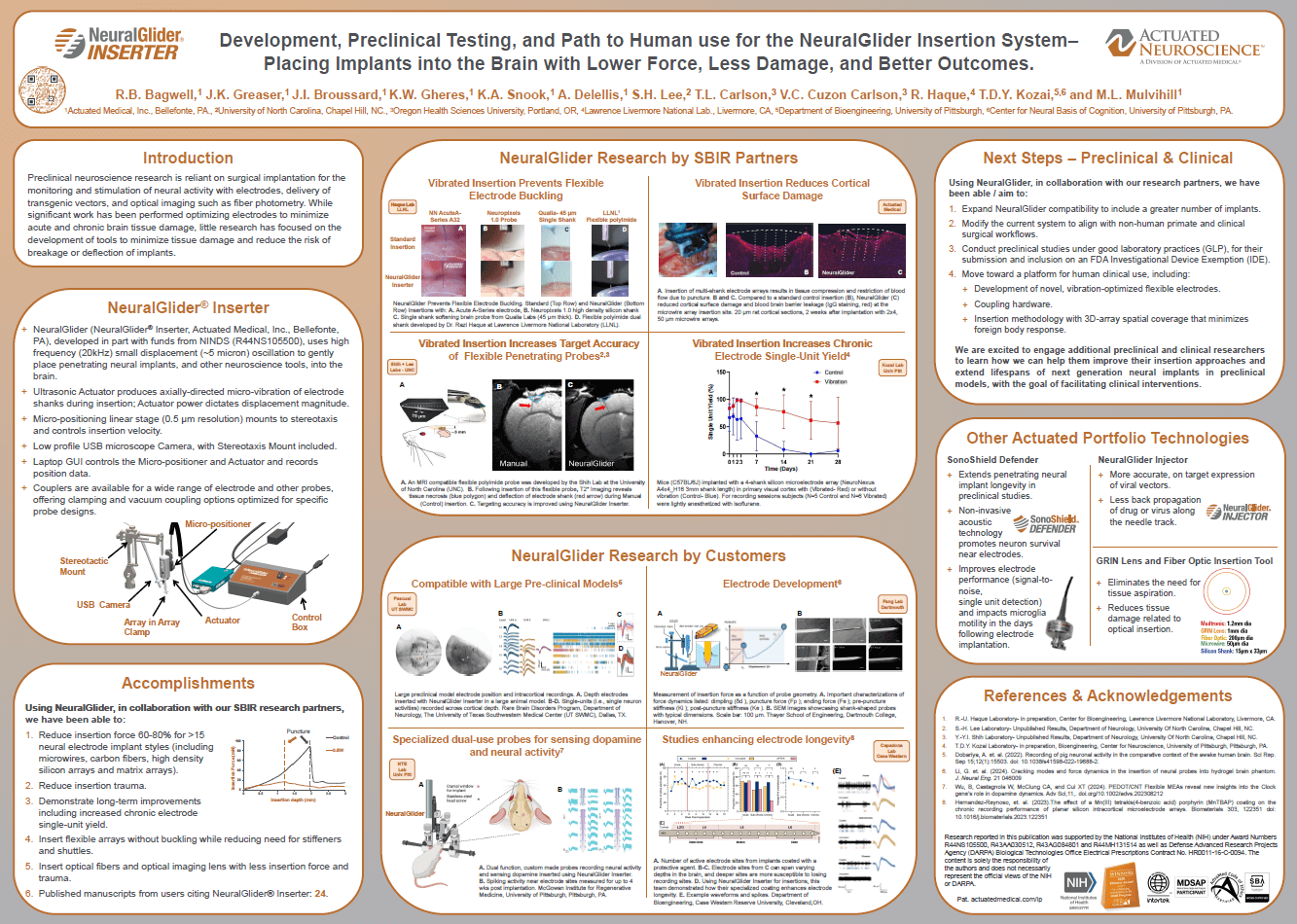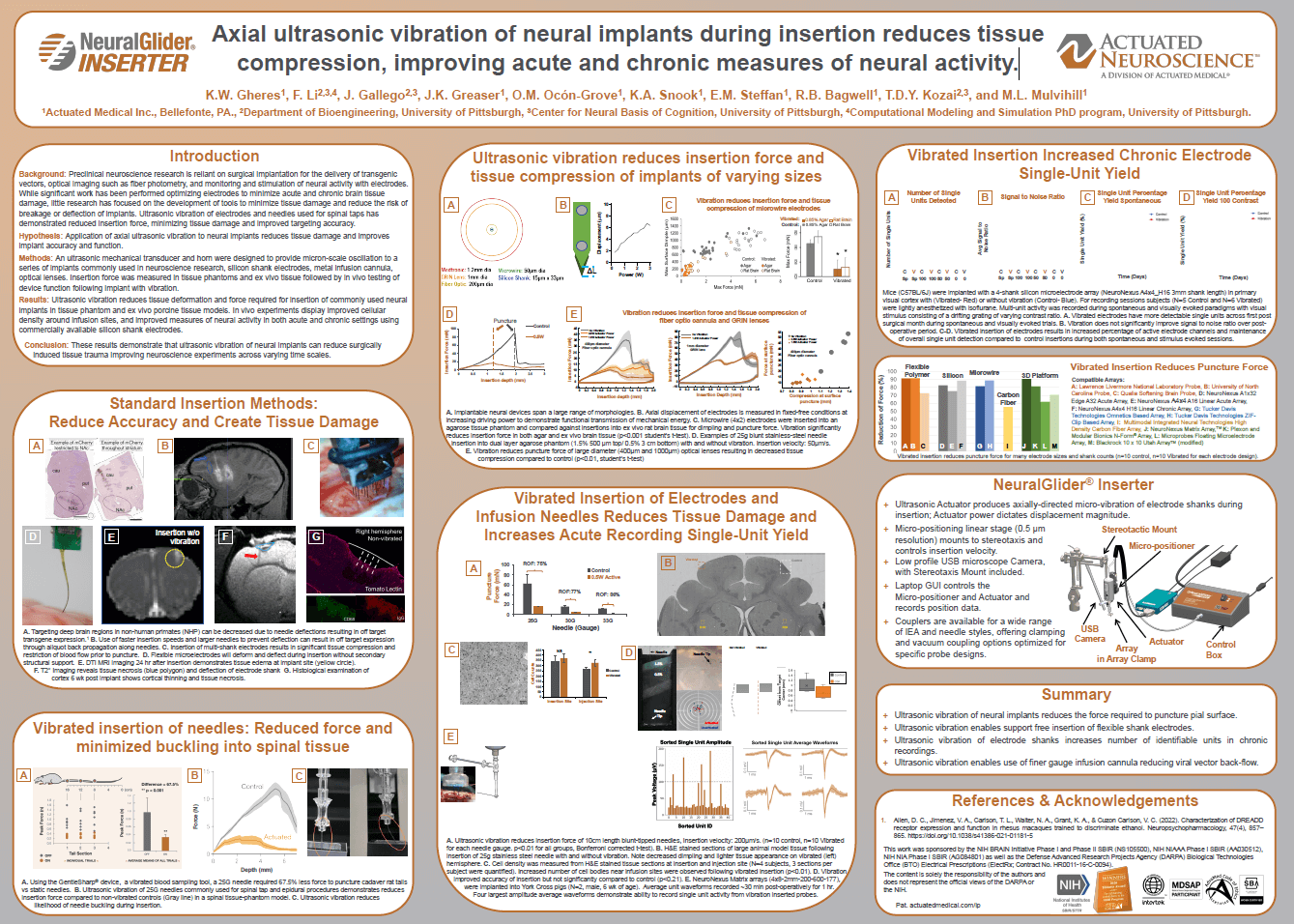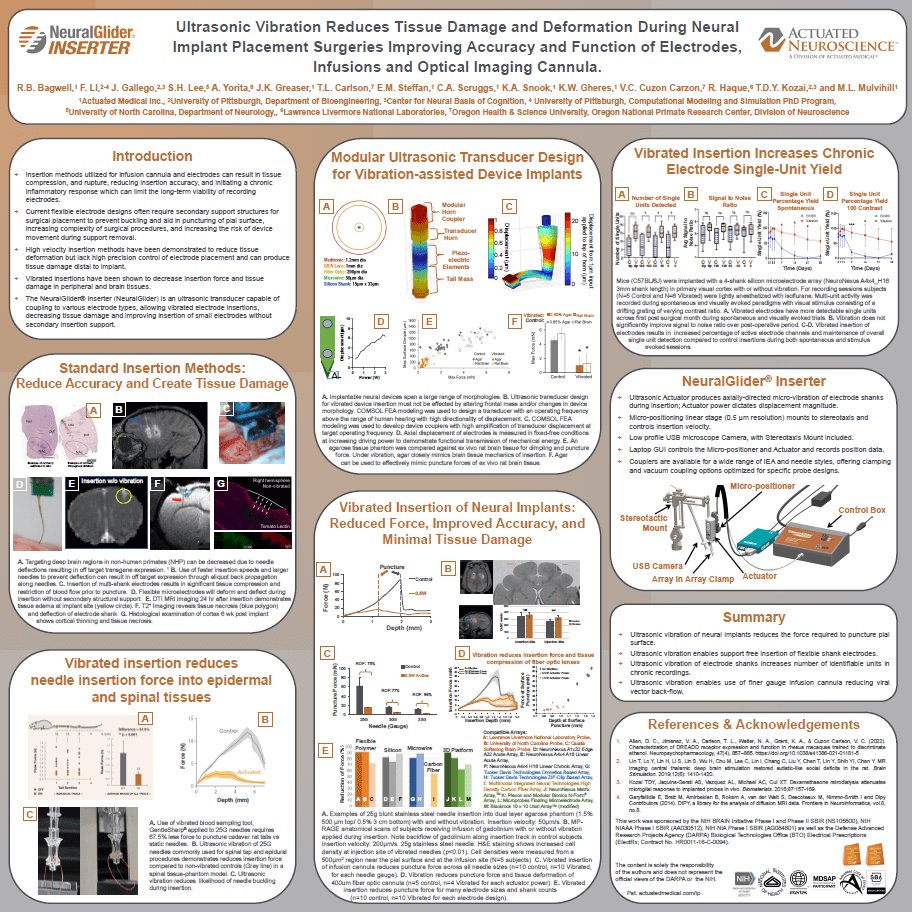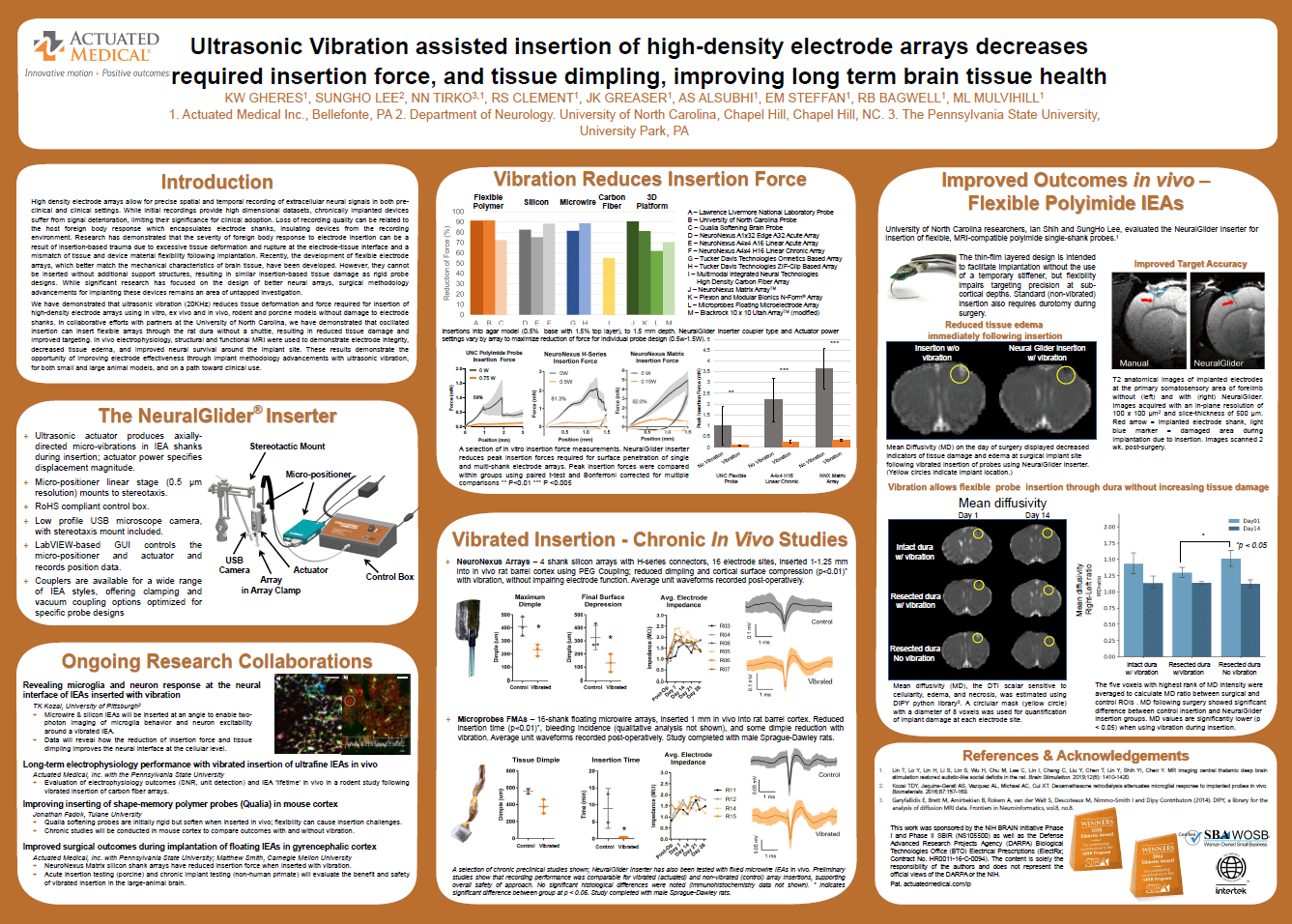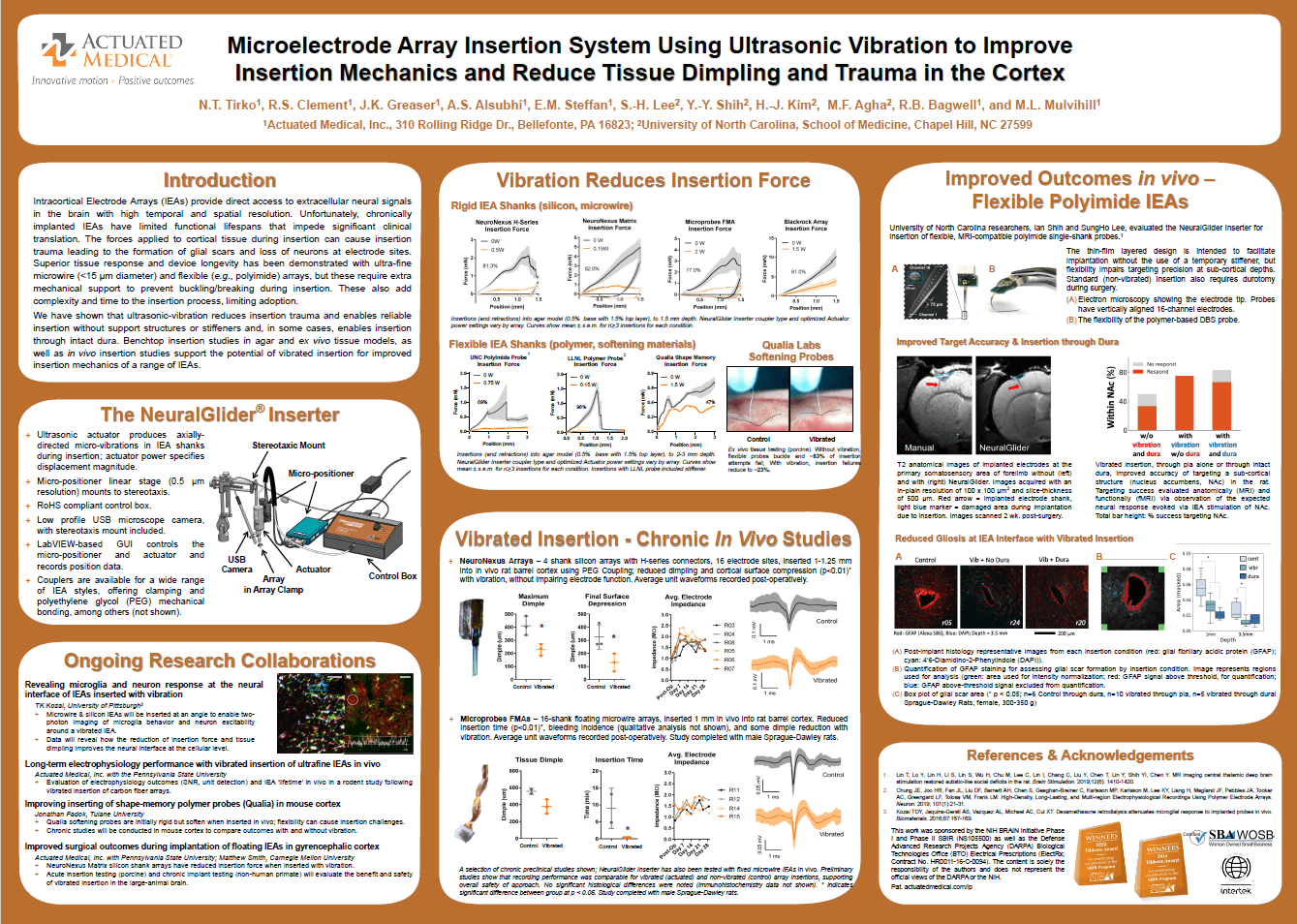Our Support, Your Research Breakthrough
Monolithic 3D Flexible MEAs Enable Microscopy-like Mapping of Neural Activity Across Brain Regions
The Hui Fang lab at Dartmouth, in collaboration with Xinyan Tracy Cui at University of Pittsburgh and others, developed a rolling-of-soft-electronics (ROSE) technique to transform planar flexible electrode arrays into monolithic three-dimensional neural probes. These customizable probes, containing hundreds of electrodes, allow stable, high-yield recording of neuronal activity in rodent and non-human primate brains without insertion aids. The ROSE probes captured spatiotemporal neural dynamics with microscopy-like resolution, enabling 3D decoding of visual stimuli and reducing inflammatory tissue responses compared with rigid silicon probes.
Y. Qiang, W. Gu, D. Jang, Y. Shin, D. Shi, K. J. Seo, G. Li, S. Vinnikova, S. Wu, A. Iyer, P. Artoni, J. Ryu, T. Bai, V. Dhawan, M. Medalla, D. L. Rosene, T. L. Moore, A. N. Koppes, R. Koppes, J. Liou, C. Chandrasekaran, X. T. Cui, S. Wang, & H. Fang. Monolithic three-dimensional neural probes from deterministic rolling of soft electronics. Nature Electronics (2025). https://doi.org/10.1038/s41928-025-01431-0
Ruthenium Oxide (RuOx) Coatings Demonstrate Electrochemical and Recording Stability for Neural Interfaces.
The Bioengineering Department at The University of Texas at Dallas, in collaboration with the School of Behavioral and Brain Sciences developed and tested sputtered Ruthenium Oxide (RuOx) coatings on microelectrode arrays (MEAs) in rat motor cortex over a 6-week period. These coatings demonstrated stable electrochemical properties and consistent single-unit action potential recordings. Findings suggest RuOx is a promising material for neural interface devices.
Justin R Abbott, Eleanor N Jeakle, Yupeng Wu, Thomas J Smith, Negar Geramifard, Bitan Chakraborty, Mahasty Khajehzadeh, Sahana Dhananjayan, Ana G Hernandez-Reynoso, Joseph J Pancrazio and Stuart F Cogan. Electrochemical stability and neural recording with sputtered ruthenium oxide electrodes subchronically in rat motor cortex. Journal of Neural Engineering (2025). https://doi.org/10.1088/1741-2552/adee49
Buckling-Resistant MEAs Enable Aid-Free Implantation and Minimize Tissue Response
Researchers at the University of Pittsburgh have developed microfabricated polyimide microelectrode arrays (MEAs) featuring a buckling-resistant, trace-stacked (BRATS) design. These BRATS MEAs can penetrate brain tissue without insertion aids, establish a stable interface, enable high-fidelity recordings, and elicit lower inflammatory responses compared to conventional flexible MEAs.
May Yoon Pwint, Delin Shi, X. Tracy Cui. Buckling-Resistant and Trace-Stacked (BRATS) Design Enables Aid-Free Implantation of Flexible Multielectrode Array with Minimized Inflammatory Tissue Response. Advanced Functional Materials (2025). https://doi.org/10.1002/adfm.202512565
Antimicrobial Coatings on Neural Probes Reduce Microbe Presence and Neuroinflammation.
Researchers at Case Western Reserve University and the Louis Stokes Cleveland Veterans Affairs Medical Center have found that coating intracortical microelectrodes with an antimicrobial titania nanotube array (TNA) reduces invasive microbes and neuroinflammation in mice. This approach may improve long-term recording performance of neural interfaces.
G. Burkhart, S.E. Grabinski, J.J. Wang, G. Glusauskas, A. Thompson, A. Lee, Z. Zhu, C.J. Donskey, H. A. von Recum, L.L. Zhang, A. Hess-Dunning, H. Amani Hamedani, J.R. Capadona. Antimicrobial coated intracortical probes reduce invading microbe abundance and subsequent neuroinflammation. Available at SSRN: https://ssrn.com/abstract=5260696
Improved Neural Recordings in Rat Motor Cortex with Amorphous Silicon Carbide MEAs
This study compares the performance of silicon-based and amorphous silicon carbide (a-SiC) microelectrode arrays (MEAs) in the rat motor cortex. Results show that a-SiC MEAs, with their smaller cross-sectional area shanks, exhibited more stable single unit activity, reduced neuroinflammation, and preserved neuronal density compared to silicon-based MEAs, suggesting a promising approach for improving the longevity of neural implants.
A Novel Carbon Coating Improves Microelectrode Performance for Neurotransmitter Sensing
Researchers developed a unique carbon coating method involving electroplating and mild annealing to enhance the performance and stability of voltammetry electrodes. By applying this coating to microelectrodes, they created carbon-coated microelectrodes (CCMs) capable of sub-second detection of dopamine in vivo with high scalability and interoperability. Integrated with electrophysiological recording sites, these CCMs were used to correlate dopamine fluctuations with high gamma power in the brain, paving the way for advanced brain interfacing.
A Primer on In Vivo Microelectrode Arrays for Neuroscience
This primer introduces in vivo microelectrode arrays (MEAs) as tools for recording extracellular action potentials in neuroscience. It covers MEA designs, construction, characterization, and applications, including effective device implantation and use in behavioral experiments. Strategies for high-quality recordings, mitigating the foreign body reaction, spike sorting approaches, analysis of sorted spikes, and future trends in MEA technology, particularly biomimetic and multifunctional devices, are also addressed. Ultimately, this primer provides a foundation in MEA technology for in vivo use.
ICMS Discrimination in Rats: Spatial Limits and Cortical Depth
Researchers investigated the spatial limits of somatotopic and depth-dependent sensory discrimination using intracortical microstimulation (ICMS) in the rat somatosensory cortex. By implanting single- and four-shank microelectrode arrays (MEAs) and employing a two-choice sensory discrimination task, they found that discrimination accuracy decreased as the spatial separation between stimulation patterns lessened. Computational modeling supported these results by showing that closely spaced patterns led to overlapping neuronal activation. Ultimately, the study offers insight into optimizing MEA design for neurostimulation applications.
Flexible MEAs Show Improved Neural Recording and Reduced Inflammation Compared to Stiff MEAs
Researchers compared stiff silicon-based and flexible polyimide-based microelectrode arrays (MEAs) in the mouse striatum over a four-week period. The study assessed neural recording quality and inflammatory tissue response, finding that flexible MEAs maintained more stable impedance, noise, and signal-to-noise ratio. Ultimately, the flexible MEAs exhibited more stable recording quality and reduced inflammation compared to the stiff probes, suggesting improved device-tissue integration.
Amorphous Silicon Carbide Neural Interface Devices for Next-Generation Neurotechnology
This dissertation details the design, fabrication, and characterization of amorphous silicon carbide (a-SiC) microelectrode arrays (MEAs) for neural recording and stimulation. Research focuses on improving MEA longevity by using a-SiC as a neural probe fabrication substrate to achieve high spatial resolution, electrochemical stability, and mechanical compatibility.
PEDOT/CNT Flexible MEAs Reveal New Insights into the Clock Gene's Role in Dopamine Dynamics
The Xinyan Tracy Cui lab at University of Pittsburgh developed new probes that can measure neuron activity and dopamine levels simultaneously. These techniques provided insight as to how circadian rhythms influence dopamine levels in mammals. These custom-made probes were optimized within the Cui lab, so when they used the NeuralGlider Inserter they were able to prevent dimpling and have a standardized and precise targeting in a brain center involved in reward and motor learning.
Recording of pig neuronal activity in the comparative context of the awake human brain
In this groundbreaking study Juan Pascual at UT Southwestern and colleagues implanted penetrating electrodes into the brain of pigs to make specific comparisons to human brain activity. Because the team was using multiple probes that were as thin as 8 micrometers, they used NeuralGlider during implantation to measure the responses of individual neurons, minimizing damage and ensuring the longevity of these probes. NeuralGlider enabled them to implant in pigs, which are a low cost large animals, and this is a key step to get to first-in-human brain computer interfaces.
Dimethyl Fumarate (DMF) Enhances Sub-Chronic MEA Performance but Worsens Chronic Neuroinflammation in Rat Models.
Researchers investigated the application of dimethyl fumarate (DMF), a clinically available antioxidant, to reduce neuroinflammation and improve microelectrode array (MEA) performance in a rat model. Over a 16-week treatment period, DMF increased active electrode yield to 42% during the sub-chronic phase (Weeks 5–11) compared to 35% in controls. However, chronic phase results showed aggravated neuroinflammation in DMF-treated rats, negating earlier performance gains. While DMF provides short-term benefits (<12 weeks), further studies are essential to explore its long-term effects and suitability for specific applications.
The effect of a Mn(III)tetrakis(4-benzoic acid)porphyrin (MnTBAP) coating on the chronic recording performance of planar silicon intracortical microelectrode arrays
Electrodes interfacing with neurons has a key challenge, in that the immune response reduces the signal over time. In this series of studies to optimize the long-term viability of electrodes, Jeffrey Capadona and his team at Case Western University coated electrodes with specialized bioactive molecules to minimize inflammation around the electrode. With NeuralGlider, this team was able successfully demonstrate that the MnTBAP enhanced electrode longevity.
Planar amorphous silicon carbide microelectrode arrays for chronic recording in rat motor cortex
With NeuralGlider, this team at UT-Dallas was able to insert electrodes as thin as 8 micrometers in diameter (1/10 the size of a human hair!) Implants lasted as long as 4 months.
Behavioral paradigm for the evaluation of stimulation-evoked somatosensory perception thresholds in rats
In this study, early career investigator award winner Ana Hernandez-Reynoso and her team at UT Dallas demonstrate how microstimulation can be used to improve sensory detection during an attention task. The NeuralGlider Inserter enabled them to implant thin recording and stimulating shanks measure brain activity during the task and during electrical microstimulation.
Nanopatterned Silicon Neural Probes Show Similar Long-Term Recording Performance but Altered Impedance and Gene Expression.
This study investigated how nanoscale surface topography, achieved through etching nanopatterned grooves into silicon-based intracortical microelectrodes, affects neuroinflammatory response and recording stability. Implanted in rats for four weeks, both nanopatterned and smooth control probes demonstrated comparable active electrode yields of approximately 50%, despite nanopatterned probes exhibiting increased impedance and noise levels. Postmortem gene expression analysis revealed significant differential expression of one gene, Sirt1, among 152 analyzed. These findings establish a foundation for further exploration of nanoscale topographies on neural probes, with implications for reducing neuroinflammation and enhancing acute recording performance.
Optimizing Insertion Techniques and Probe Design to Minimize Tissue Damage and Enhance Chronic Neural Recording Stability.
This dissertation addresses the challenge of maintaining long-term performance of high-density CMOS neural probes for brain recording. Focusing on reducing acute tissue damage during implantation, the study measured and modeled insertion forces as a function of probe features such as cross-sectional dimensions and tip geometry. Results showed that sharp tip angles and optimized insertion speeds significantly decrease tissue disruption and subsequent foreign body response. Based on these insights, a closed-loop insertion protocol was developed, and an on-probe force sensor was integrated to improve implantation precision. These advancements aim to mitigate tissue trauma, thereby enhancing the chronic stability and functionality of dense, tissue-penetrating neural interfaces.
Silicon Carbide and Conductive Coatings Support Stable, Long-Term Neural Recording, with Controlled Foreign Body Response.
This dissertation investigates the use of amorphous silicon carbide (a-SiC) as a platform for fabricating durable neural microelectrodes. Devices with 8 μm thickness and 20 μm width, coated with sputtered iridium oxide (SIROF), were implanted into rat motor cortex for 16 weeks. Results demonstrated electrochemical stability and neural recording capabilities on approximately 90% of channels at 1 week, decreasing to 50% at 16 weeks, with a depth-dependent foreign body response showing more reaction near the pial surface. RuOx-coated a-SiC devices, tested over 6 weeks, maintained electrochemical stability and recorded signals on 75% of channels throughout. The study also explored tantalum interconnect layers, showing that priming layers influence crystallographic phases and electrical conductivity. Additionally, titanium nitride (TiN) films of varying thickness exhibited charge injection similar to noble metals and benefited from anodic biasing for stimulation. These findings support the development of long-lasting, biocompatible neural interfaces with optimized electrical properties for chronic applications.
Chondroitin Sulfate Coating Enhances Biocompatibility and Recording Stability of Neural Electrodes In Vivo.
This study explores a novel chondroitin sulfate (CS)-based hydrophilic coating for neural recording electrodes to reduce biofouling and improve tissue integration. In vitro results showed significant reductions in protein fouling and increased neurite attachment and outgrowth, along with decreased microglial activation. In vivo, CS-coated electrodes implanted in the mouse cortex demonstrated lower biofouling, higher neuronal presence, and reduced microglial response after 1 week of implantation. Electrical testing in the mouse striatum revealed lower impedance, with comparable signal-to-noise ratios and a higher single-unit yield (74%) compared to uncoated controls (67%) on day 1. These findings highlight the coating’s potential to enhance electrode biocompatibility, stability, and recording performance for chronic neural interface applications.
Understanding Cracking Mechanisms and Force Dynamics in Neural Probe Insertion into Hydrogel Phantoms.
This study investigates the insertion mechanics of neural probes into hydrogel-based brain phantoms, focusing on crack formation and its impact on insertion forces. Systematic experiments with probes of varying sharpness and dimensions demonstrate two distinct cracking modes: straight cracks associated with sharp, slender probes resulting in low and consistent forces, and branched cracks with blunt, thick probes leading to high, rapidly increasing forces due to internal compression. Finite element analysis elucidates the transition between these cracking modes and challenges traditional views that attribute increased forces solely to friction. These findings offer new insights into the design of neural probes, improving understanding of tissue interaction dynamics during implantations and aiding in reducing insertion-related tissue damage.
Microvibration-Assisted Injection Technique Reduces Tissue Damage During Brain Microdevice Deployment.
This study presents a novel injection method and a specialized injection aid designed to minimize tissue damage when inserting microfabricated neural microdevices into brain tissue. The technique employs microvibrations to facilitate microdevice injection, resulting in a 7.4% reduction in tissue damage compared to conventional methods, as confirmed through cryosectioning analysis in agarose and brain tissue. This minimally invasive approach aims to improve the safety and efficacy of deploying delicate neural microdevices, supporting the development of advanced implantable brain interfaces with reduced tissue trauma.
MnTBAP Coating Differentially Enhances Chronic Neural Recordings Based on Neuron Type and Cortical Depth.
This study investigates the effects of Mn(III) tetrakis(94-benzoic acid)porphyrin (MnTBAP), an antioxidant coating, on the long-term recording performance of intracortical microelectrode arrays (MEAs). Neural signals were classified as putative inhibitory or excitatory based on waveform features to examine differential benefits of MnTBAP. Results showed that MnTBAP improved inhibitory neuron signals on middle cortical layer (L5) electrode sites and excitatory neuron signals on superficial layers (L2/3 & L4). The findings suggest that decreases in chronic recording quality are influenced by neuronal cell type and cortical depth, and that antioxidant coatings like MnTBAP can differentially benefit neuron classes depending on their cortical location. These insights highlight the importance of considering both cell type and cortical depth for enhancing long-term neural interface performance.
Design, Manufacturing, and Implantation Strategies for Invasive Microelectrode Arrays in Brain-Machine Interfaces.
This review discusses the development of invasive microelectrode arrays (MEAs) used for high-resolution neuronal recordings and stimulations to study brain function. Over decades, various MEA types—microwire, silicon-based, and flexible substrates—have been created utilizing emerging materials, innovative designs, and advanced manufacturing techniques. The implantation of these flexible MEAs poses new challenges, particularly related to penetrating the brain’s protective membranes. The paper evaluates design considerations, manufacturing processes, and surgical strategies for in vivo brain-machine interface applications, highlighting solutions for implantation difficulties. It also identifies current research gaps and proposes future directions for the development of more effective, minimally invasive MEAs for brain research and clinical applications.
Heterogeneous Integration of Ultrafine Polymer Chiplets Enables Advanced Flexible Bioelectronics.
This study introduces a robust chiplet-level heterogeneous integration (CHIP) technique for combining polymer-based electronic and optoelectronic circuits. Ultrathin polymer chiplets are vertically bonded at room temperature and shaped into application-specific forms with monolithic Input/Output (I/O). Using this method, a flexible 3D integrated optrode was developed, featuring high-density microelectrodes for electrical recording, micro-LEDs for optogenetic stimulation, temperature sensors for bio-safe operation, and shielding designs to mitigate artifacts. CHIP offers high-yield, scalable 3D integration with efficient area utilization and miniaturized I/O. Characterization confirmed system effectiveness and revealed frequency-dependent optoelectronic artifacts, highlighting CHIP’s potential for diverse polymer-based devices and applications.
Flexible and Extensible Ribbon Cables Enhance Neural Interface Performance.
This study reports on the design and characterization of thin-film ribbon cables for implanted neural stimulation and recording devices. Employing amorphous silicon carbide (a-SiC) and polyimide as structural elements, with titanium/gold thin films as electrical traces, the cables were designed for flexibility and extensibility. Linear and serpentine traces were investigated, along with a lattice design achieving 300% elongation without failure. Ribbon cables maintained electrical integrity through 50,000 cycles of 45% elongation. An electrical interconnect was created via conductive epoxy to connect a ribbon cable to an a-SiC MEA in rat cortex, successfully recording neuronal activity. These cables are anticipated to accommodate large extensions and reduce tethering forces, potentially improving chronic recording performance.
Chronic Stability of Local Field Potentials Using Amorphous Silicon Carbide Microelectrode Arrays Implanted in the Rat Motor Cortex
In this study, scientists developed custom made, ultrathin probes made of silicon carbide were compared to industry standard probes for longevity. Because of NeuralGlider they were able to insert ultrathin probes and record for up to16 weeks post implantation.
Influence of Implantation Depth on the Performance of Intracortical Probe Recording Sites
Because of NeuralGlider, Sourav S Patnaik and colleagues from UT Dallas successfully compared single shank and multiple shank probes. They discovered that electrode sites that are deeper don’t last as long as those that are shallower.
Reactive Amine Functionalized Microelectrode Arrays Provide Short-Term Benefit but Long-Term Detriment to In Vivo Recording Performance
The immune response reduces electrode usability over time. Jeffrey Capadona and his team at Case Western University coated electrodes with specialized bioactive molecules to minimize inflammation around the electrode. Due to NeuralGlider, this team was able successfully demonstrate that this reactive amine did not enhance electrode longevity.
In Vivo Characterization of Intracortical Probes with Focused Ion Beam-Etched Nanopatterned Topographies
This team used NeuralGlider to successfully minimize damage to insert custom made electrodes etched with gold and titanium into the brain. The yield using this custom etching extended electrode life by 4 weeks compared to industry standard.
Characterization of Active Electrode Yield for Intracortical Arrays: Awake versus Anesthesia
The focus of this research group is to study the lifespan of specialized recording probes. NeuralGlider enabled the University of Texas at Dallas group to successfully test the effects of anesthesia on changes in neural activity from their specialized probes.
Real-Time assessment of rodent engagement using ArUco Markers: a scalable and accessible approach for scoring behavior in a nose-poking go/no-go task.
Researchers at UT Dallas and West Virginia collaborated to develop an automated assessment of animal behavior. With NeuralGlider, they were successfully able to implant stimulating and recording electrodes at 0.1 mm/s while actuated to their target location. Neural data will be published in an upcoming paper.
Low-Intensity pulsed ultrasound stimulation(LIPUS) modulates microglial activation following intracortical microelectrode implantation
Actuated Medical collaborated with a team at the University of Pittsburgh to develop a strategy to lengthen the lifespan of implanted electrodes. First, the Pittsburgh team used NeuralGlider to successfully implant fine electrodes. Then, using an acoustic device engineered at Actuated, the team at Pitt used gentle acoustic waves to reduce inflammation around the electrodes, lengthening the usability window of these implanted devices.
Mechanically Robust, Softening Shape Memory Polymer Probes for Intracortical Recording
Engineers at UT Dallas created a new type of electrode array. Industry standard arrays are made from silicon, which can be brittle. So, the team led by Dr. Joseph Pancrazio used a novel shape memory polymer that is rigid at room temperature but softens in the brain. NeuralGlider successfully enabled the team to determine the superiority of shape memory polymer probes (which did not break) compared to industry standard silicon probes.
A Scalable, Practical Approach to Neural Modulation & Recording
A thesis, “A Scalable, Practical Approach to Neural Modulation & Recording”, explores advancements in Brain Machine Interface (BMI) technologies. It presents a methodology for integrating microwire bundles to CMOS microchips, allowing for scalable neural modulation and recording. The study investigates microwire penetration mechanics, identifying electropolishing as a method to improve penetration. Finally, the research develops a method for patterning sensitive organic electronic materials for neural amplifier architecture.
Posters

